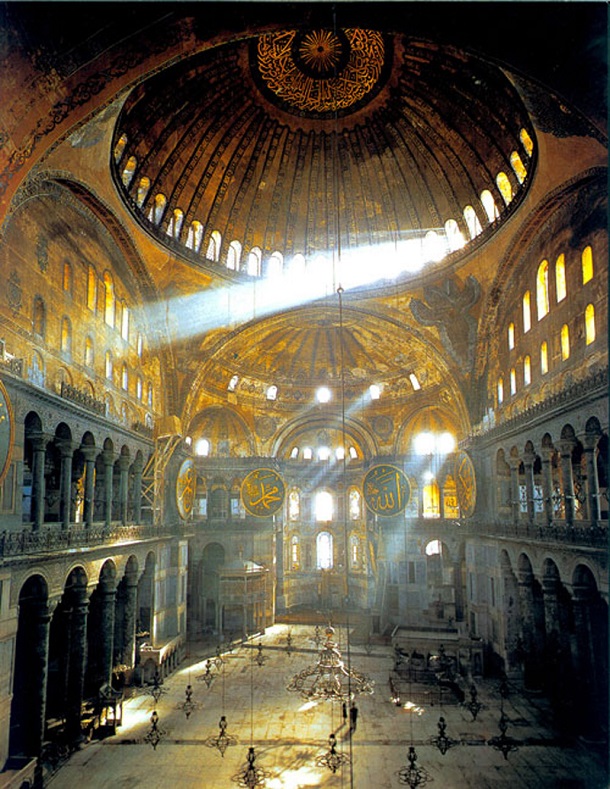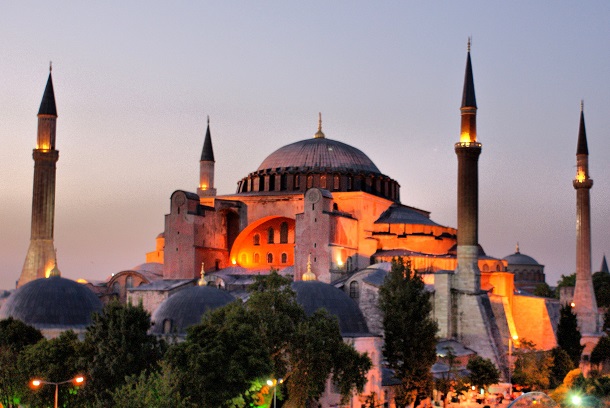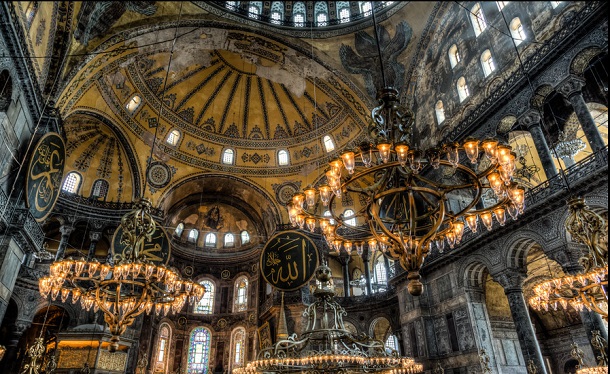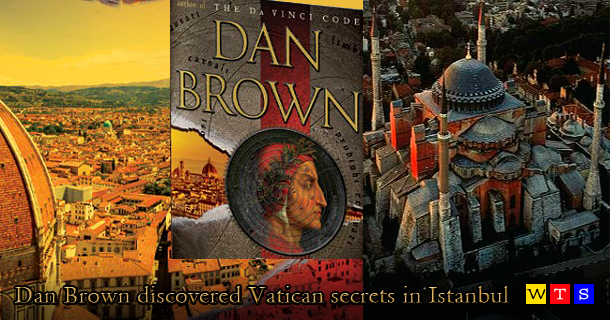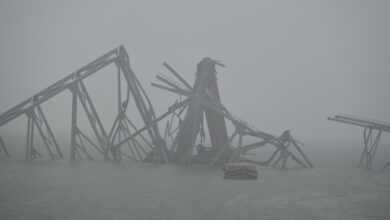Dan Brown’s latest novel,sent to the protagonist Robert Langdon’s Inferno Istanbul for the Hagia Sophia which is an important place in world history, but do we realy know the Hagia Sophia.
On page 334 of Dan Brown’s new novel Inferno, Dan Brown’s tweedy Harvard iconographer Robert Langdon reveals to Sienna Brooks – a British-born misfit genius who gallops around three favourite tourist destinations with him in this latest adventure – that “We’re in the wrong country”. Cue a flight out of Venice, where a plot rammed to bursting-point with guide-book factoids and the vintage formulae of apocalyptic science-fiction has shifted from its opening location in Florence.
Readers will know soon enough that the third, and decisive, city of Inferno is Istanbul. Once there, we learn under the gilded dome of the cathedral-mosque-museum of Hagia Sophia that “the traditions of East and West are not as divergent as you might think”.
Dan Brown’s book says the status of the famous hero Robert Langdon inside Hagia Sophia.Come take a look at 1500 years Istanbul landmark Hagia Sophia.
Dan Brown Inferno:What is Hagia Sophia ?
The dome and minarets of Hagia Sophia are the symbols of Istanbul. This is the only building in the world to have served as a Catholic Cathedral and as the seat of two religions, Greek Orthodox Christianity and Sunni Islam.
The Hagia Sophia that we see today is to a great extent, despite the rebuilding work carried out after regular earthquakes, the building that was consecrated on the 27th December 537 by the Roman Emperor Justinian. It would be the greatest church in Christendom for a thousand years, until St. Peter’s in Rome was completed.
Hagia Sophia’s massive dome and gigantic proportions, visible in the image above, were believed by many to have been the work of the divine. It heavily influenced the architecture of mosques and churches and it’s grandeur was said to have led Russia to convert to Orthodox Christianity, not Catholicism. Relics such as the shroud of Mary, nails from the true cross and the tombstone of Jesus were some of its treasures, until the city was ransacked during the Fourth crusade.
Much of the above is well known. What I would like to focus on is the lack of any crypt, cellar, or underground areas in the building. My question is, why are these features missing in Hagia Sophia?
Crypts were well known architectural features at the time the building was designed. Both the Church of the Holy Sepulchre in Jerusalem, constructed in 326-330, and Old St. Peter’s in Rome, constructed at the same time, both at the time the original Hagia Sophia was constructed, have extensive underground areas. The questions is, why would Isidore of Miletus and mathematician Anthemius of Tralles, architects of Hagia Sophia, have left such an important feature as underground chambers out of the design of Hagia Sophia?
In Rome the catacombs, passages and tunnels under old St. Peter’s were the result of the building being placed over a cemetery and near a temple to an Etruscan god. In Jerusalem the Church of the Holy Sepulchre was placed over a temple to Aphrodite, the goddess whose priestesses engaged in ritual prostitution. That site was found to cross over the tomb of Jesus by Helena, the mother of the Roman Emperor Constantine. The underground section of the site is now its main attraction.
Sure, the tomb of the Doge of Venice is located inside Hagia Sophia, but that wasn’t constructed until 1205, and it’s not an impressive structure.
The main argument for the existence of underground areas beneath Hagia Sophia are therefore as follows:
1. Crypts were well known features of early Christian churches from before the construction of Hagia Sophia. They were used in the early Christian period in North Africa at Orleansville and Djemila in Algeria, and at Saint John Studio in Constantinople itself.
2. Where Christian churches were built over late Roman era temples, which included underground areas, such as a mithraeum, these were adapted to serve as a crypt. Hagia Sophia was built on the top of the hill around which the then old Greek city preceding Constantinople had originally been founded. There is every reason to believe that a Roman era temple would have preexisted the earliest Christian Hagia Sophia, perhaps dedicated to Isis, as the nearby Hagia Eirene was built over a temple dedicated to Aphrodite or possibly to the Greek Goddess Eirene.
3. The two other main patriarchal cathedrals of the Christian world at that time, Jerusalem and Rome, both featured important underground areas, the tombs of Jesus and St Peter respectively, as discussed above.
Now it certainly could be true that Hagia Sophia is the exception here, but I think we should consider why the entrance to any underground area would have been concealed. What could be the motivation for concealing any tomb, tunnel or crypt under Hagia Sophia?
When Constantinople fell to the Ottoman armies in 1453 it would have been clear to the guardians of Hagia Sophia that the church would be desecrated and turned into a mosque if the city fell, as appeared likely to many. They had motivation and plenty of time to properly conceal any entrances that existed.
To me the possible takeover of the city provides clear motivation to seal up any underground chambers under Hagia Sophia. The existence of sacred relics and the principles of Byzantine secrecy only add to such motivation.
Legends speak about such places under Hagia Sophia, one talks about the devil being imprisoned there, but that isn’t proof that any such place exists. Nor do my arguments above.
The only thing that will prove the existence or non existence of such features is a proper geophysical survey using ground penetrating radar and the latest magnetometer equipment.
Until such a project takes place we can only speculate about what might be under there.
The secrets of Hagia Sophia are as follows:
- The current Hagia Sophia is the third Hagia Sophia constructed at the exact same location. After the construction of the first two, this “great church” (Megale Ekklesia) was constructed. It wasn’t called Hagia Sophia at first; it was actually called the Great Church for a long time.
- Hagia Sophia is The East Roman Patriarchate Church. St. Sinod Assembly had been convened at the rooms located in the South front aisle of the Hagia Sophia.
- The second Hagia Sophia’s West wall groundworks are available for viewing, and some monumental parts of it welcome the visitors with lambs that symbolize the apostles.
- In addition to Hagia Sophia’s main construction, two other buildings that are predicted to be baptisteries and that date back much longer than the main construction itself exist. One of these is located in the northeast and is referred to as the treasure building, whereas the other baptistery is located in the southwest.
- The Hagia Sophia includes pieces belonging to Anatolian and Middle Eastern civilizations that date back to the Eastern Roman period, Western Roman period and even the Pagan period. These include the Beautiful Door dating back to second century B.C from Tarsus as well as cubes, countless columns, marbles and many more artifacts from the Hellenistic period.
- The Hagia Sophia includes not only priests and patriarchs but also a monastery, situated close to the main courtyard, where many priests resided.
- The main ground where the Hagia Sophia rests has been elevated with the remains from old buildings and construction residue, and the square rests on a foundation of several civilizations’ remains.
- The Hagia Sophia is the site where Byzantine Emperors were crowned. They would be welcomed by the patriarch and crowned in a designated area within the church naos.
- All the mosaics within the Hagia Sophia contain human figures and date back to 842 A.D. All pieces from previous periods have been destroyed due to iconoclasm.
- Particular pieces within the Hagia Sophia were taken outside of Turkey during different periods and are now being exhibited in various museums in Europe.

